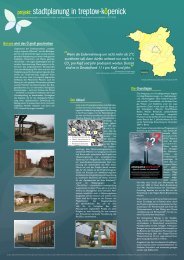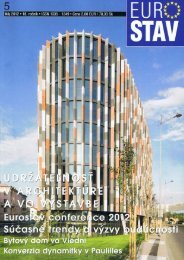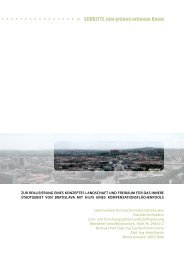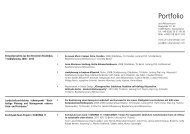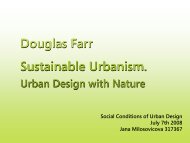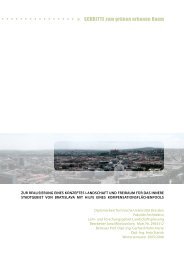Thesis document - Jana Milosovicova - Urban Design English
Thesis document - Jana Milosovicova - Urban Design English
Thesis document - Jana Milosovicova - Urban Design English
- No tags were found...
Create successful ePaper yourself
Turn your PDF publications into a flip-book with our unique Google optimized e-Paper software.
as the immense climatic effects of vegetation in built-up areas. Theseauthors acknowledge the problem of evapotranspiration loss; howeveravoid suggesting consequent design solutions. Givoni, for instance, explicitlydenies the possibility of planting on buildings and in areas oncetaken by buildings (Givoni 1998, p. 282), undervaluing the notion thatthe high temperatures can be mitigated with the help of vegetated builtsurfaces.While the environmental aspects of urban climate are being avoidedin most of the urban design-related sources, there is a comprehensiveliterature on these issues, such as “Stadtökologie” (<strong>Urban</strong> Ecology) bySukopp and Wittig (1998) or “<strong>Urban</strong> Ecology” by Marzluff et al. (2008).These sources however give only general text recommendations forclimate-related urban planning and omit particular urban design recommendations.Not surprisingly, some of the authors disagree on what measures areuseful to tackle the global warming effects on cities, for example thosebased on management of water cycles. Givoni, for example, states that“some of the factors which affect the urban heat island are meteorogicaland not subject to human intervention, such as cloudiness and theregional wind speed” (Givoni 1998, p. 245); while, in turn, other authorsclaim that it is human intervention reflected in the design of citiesthat restrains the evapotranspiration from formerly vegetated areas(Kravčík et al. 2007, p. 14-15). This has an effect on the cloudiness andthe amount of solar radiation that reaches the city, increasing the temperatures.<strong>Urban</strong> design also plays an important role in enabling naturalventilation conditions by steering regional winds into cities (e.g. Kuttlerin Marzluff 2008).Another finding is that the notion of albedo seems to be overemphasized.It is commonly believed that a higher surface reflectance affectsthe total energy balance, thus lowering the urban heat island effect(Sass, online; Emmanuel 2005; Gartland 2008; Givoni 1998, p. 308).However, it seems that although the microclimate temperatures areaffected, the effect of solar reflection on the total radiation balance ofthe city (and on the urban heat island) is in fact minimal. See more onp. 17-18.As briefly introduced above, the thorough literature review on the effectsof the built form on climate indicates that there are many factorsin the physical structure of the city that influence urban climaticconditions. This implies that there is not only one single measure to beapplied in order to achieve a well-balanced and physically acceptableurban climate. Much more than that, a well-thought-out set of measuresmust be implemented. According to the given local conditions, onemeasure might be of higher priority and weighting than another.In the sections 2.1 – 2.3, a detailed description of the findings, basedon the reviewed literature, will be presented. The aim is to managea thorough knowledge base for the main subject of this <strong>Thesis</strong>, the“Climate-Sensitive <strong>Urban</strong> <strong>Design</strong>”.12Climate Sensitive <strong>Urban</strong> <strong>Design</strong> in Moderate Climate Zone: Responding to Future Heat Waves. Case Study Berlin Heidestrasse/Europacity



